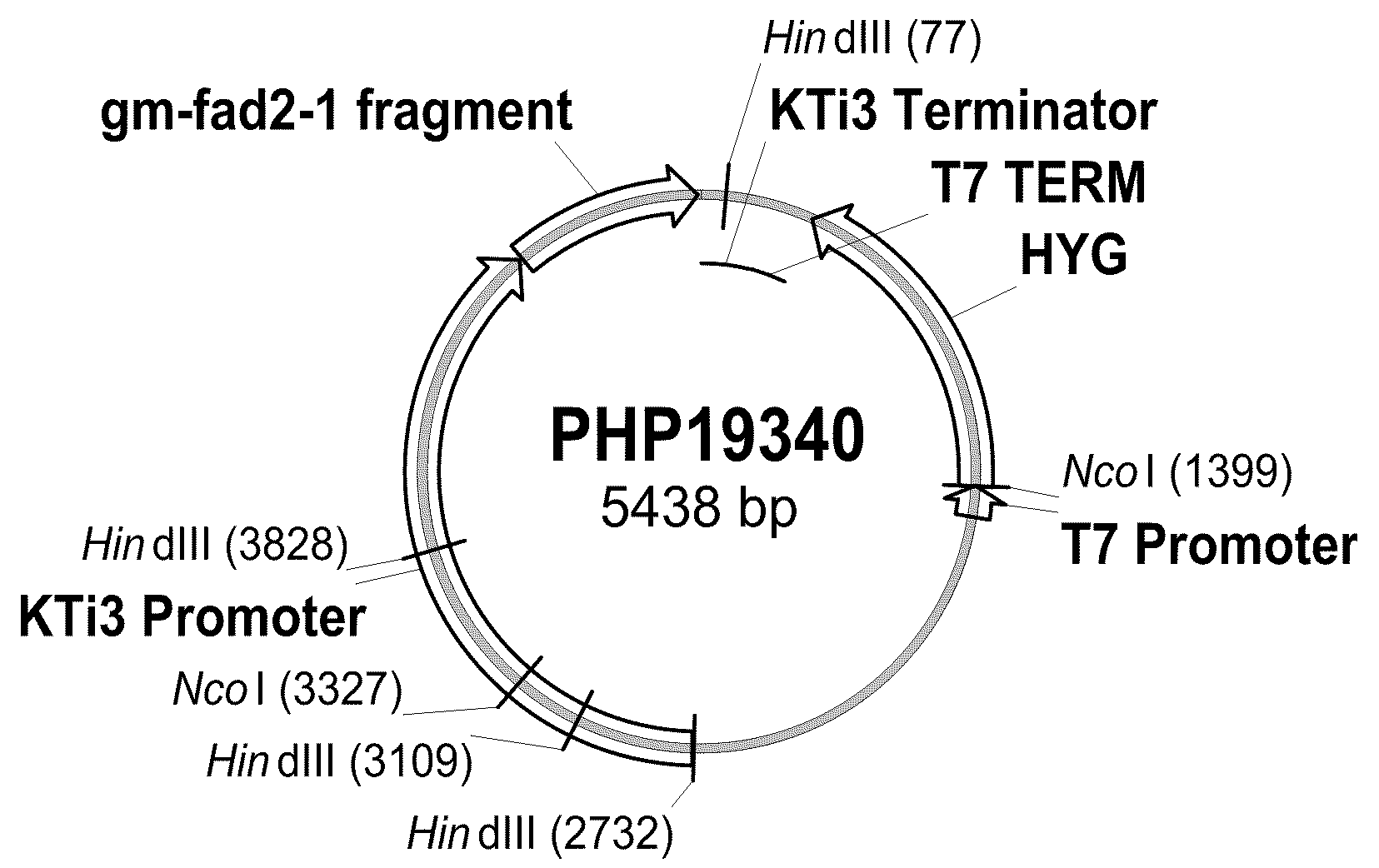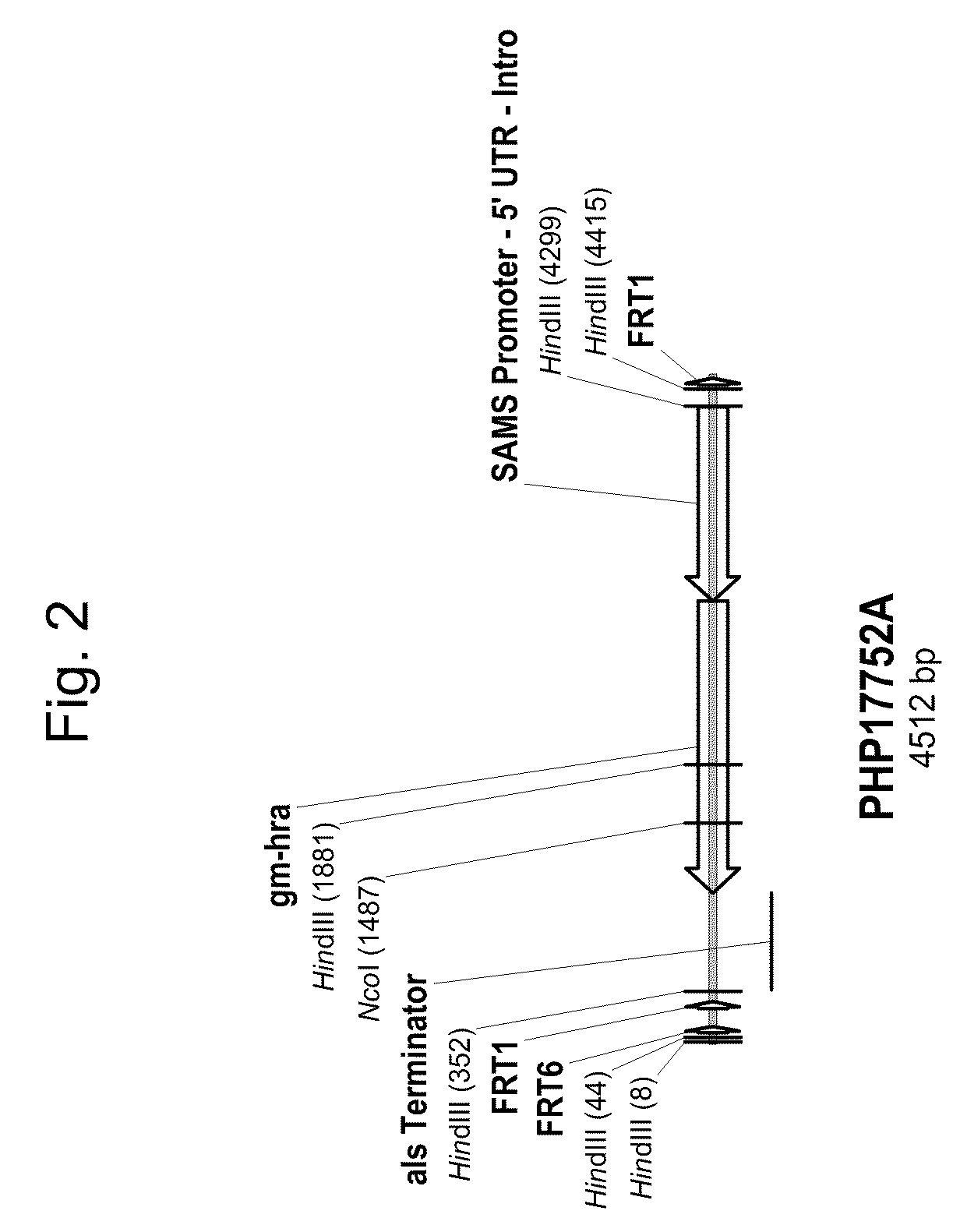Soybean event dp-305423-1 and compositions and methods for the identification and/or detection thereof
a technology of soybean and event, applied in the field of molecular biology, can solve the problems of unstable soil, reduced levels of polyunsaturated fats, and development of disagreeable odors and flavors, and achieve the effect of high oleic acid phenotype and tolerance, and enhanced breeding efficiency
- Summary
- Abstract
- Description
- Claims
- Application Information
AI Technical Summary
Benefits of technology
Problems solved by technology
Method used
Image
Examples
example 1
Genetic Material Used to Produce the DP-305423-1 Event
[0217]Soybean (Glycine max) event DP-305423-1 was produced by particle co-bombardment with fragments PHP19340A (FIG. 1; SEQ ID NO:1) and PHP17752A (FIG. 2; SEQ ID NO:2). A summary of the elements and their position on the PHP19340A fragment is presented in Table 3 and for the PHP17752A fragment in Table 4. These fragments were obtained by Asc I digestion from a source plasmid. Fragment PHP19340A was obtained from plasmid PHP19340 (FIG. 3; SEQ ID NO:3) and fragment PHP17752A was obtained from plasmid PHP17752 (FIG. 4; SEQ ID NO:4). A summary of the elements and their position on each of the plasmids, PHP19340 and PHP17752, are described in Tables 5 and 6, respectively.
[0218]The PHP19340A fragment contains a cassette with a 597 bp fragment of the soybean microsomal omega-6 desaturase gene 1 (gm-fad2-1) (Heppard et al., 1996). The presence of the gm-fad2-1 fragment in the expression cassette acts to suppress expression of the endoge...
example 2
Method of Transformation and Selection for the Soybean Event DP-305423-1
[0228]For transformation of soybean tissue, a linear portion of DNA, containing the gm-fad2-1 gene sequence and the regulatory components necessary for expression, was excised from the plasmid PHP19340 through the use of the restriction enzyme Asc I and purified using agarose gel electrophoresis. A linear portion of DNA, containing the gm-hra gene sequences and the regulatory components necessary for expression, was excised from the plasmid PHP17752 through the use of the restriction enzyme Asc I and purified using agarose gel electrophoresis. The linear portion of DNA containing the gm-fad2-1 gene is designated insert PHP19340A and is 2924 bp in size. The linear portion of DNA containing the gm-hra gene is designated insert PHP17752A and is 4511 bp in size. The only DNA introduced into transformation event DP-305423-1 was the DNA of the inserts described above.
[0229]The transgenic plants from event DP-305423-1 ...
example 3
Southern Analysis of Plants Containing the DP-305423-1 Event
[0232]Materials and Methods: Genomic DNA was extracted from frozen soybean leaf tissue of individual plants of the T4 and T5 generations of DP-305423-1 and of control (variety: Jack) using a standard Urea Extraction Buffer method. Genomic DNA was quantified on a spectrofluorometer using Pico Green® reagent (Molecular Probes, Invitrogen). Approximately 4 μg of DNA per sample was digested with Hind III or Nco I. For positive control samples, approximately 3 pg (2 genome copy equivalents) of plasmid PHP19340 or PHP17752 was added to control soybean genomic DNA prior to digestion. Negative control samples consisted of unmodified soybean genomic DNA (variety: Jack). DNA fragments were separated by size using agarose gel electrophoresis.
[0233]Following agarose gel electrophoresis, the separated DNA fragments were depurinated, denatured, neutralized in situ, and transferred to a nylon membrane in 20×SSC buffer using the method as ...
PUM
| Property | Measurement | Unit |
|---|---|---|
| temperature | aaaaa | aaaaa |
| temperature | aaaaa | aaaaa |
| pH | aaaaa | aaaaa |
Abstract
Description
Claims
Application Information
 Login to View More
Login to View More - R&D
- Intellectual Property
- Life Sciences
- Materials
- Tech Scout
- Unparalleled Data Quality
- Higher Quality Content
- 60% Fewer Hallucinations
Browse by: Latest US Patents, China's latest patents, Technical Efficacy Thesaurus, Application Domain, Technology Topic, Popular Technical Reports.
© 2025 PatSnap. All rights reserved.Legal|Privacy policy|Modern Slavery Act Transparency Statement|Sitemap|About US| Contact US: help@patsnap.com



